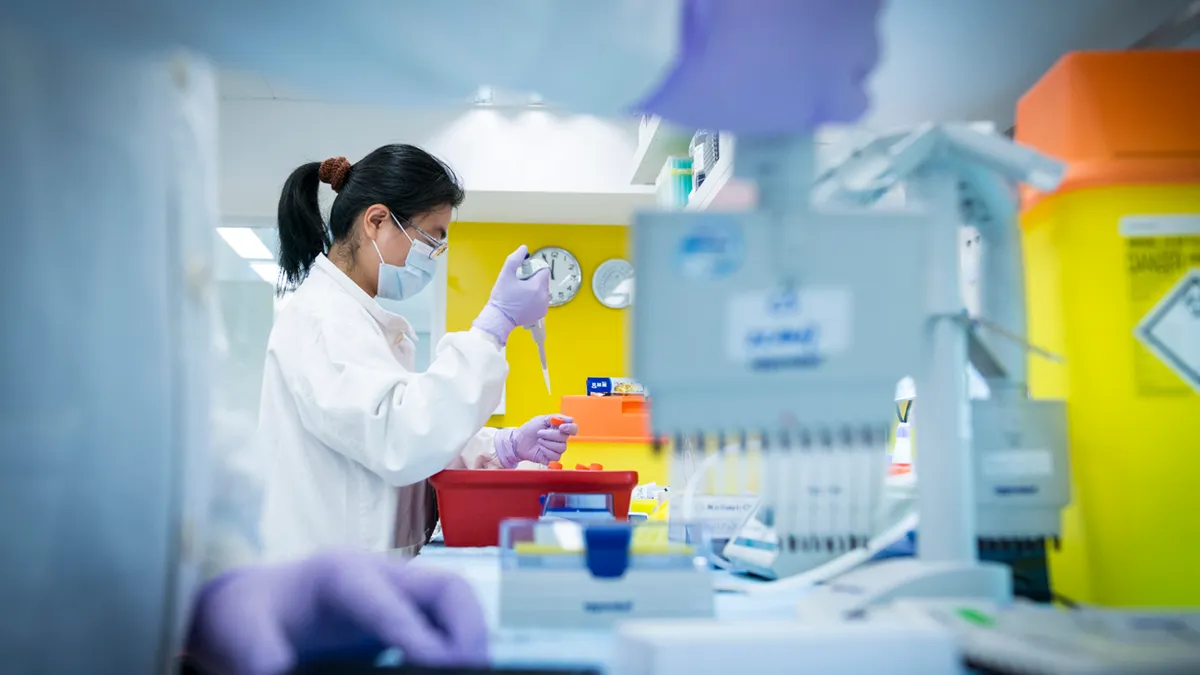Just one month into his new role as a Jacobs Engineering executive vice president, Ken Gilmartin has found himself in the middle of a national spotlight.
As joint lead of the company’s People & Places Solutions business unit, he oversees critical construction projects like pharmaceutical facilities that put the company squarely on the front line in the fight against the COVID-19 pandemic.
It’s no secret that the global health community is working at a frenetic pace toward a coronavirus vaccine, and Jacobs has a role to play there because, when that day comes, pharmaceutical manufacturers will need to be ready to ramp up production immediately.
To that end, Gilmartin said, the necessary retrofits, which would typically take 18 months, are on track to wrap up in an astonishing 18 weeks instead on some projects. Jacobs currently has nine of these retrofits underway around the world, including an AstraZeneca vaccine facility retrofit project in the West Chester, Ohio, that was announced in June.
“Everybody has rolled up their sleeves,” he said. “Everybody is fully engaged in this … so that we have as much production capacity as quickly as possible.”
Such an accelerated schedule is bound to put stress on everyone from the Jacobs team down to subcontractors and vendors, but Gilmartin said there is a motivating “esprit de corps” that comes with working on something so mission-critical.
“There's a sense of that social purpose — that you are contributing to really being part of the solution for a global pandemic that affects everybody,” he said.
Health care concerns
Company-wide, Jacobs' health care-related projects lately have been as varied as drug manufacturing plant retrofits to hospital renovations and shipping container conversions into intensive care space.
The latter was part of an international coalition of design professionals, medical and military experts and non-governmental organizations formed with the goal of providing extra ICU spaces with biocontainment capabilities similar to an isolation ward. The CURA (Connected Units for Respiratory Ailment) project saw 20-foot intermodal shipping containers turned into “plug-in” ICU pods. The first pod was installed at a field hospital in Turin, Italy.
The coronavirus has also created an opportunity for the company to integrate technology from its other business units, as well as accelerate the development of other advances, in order to meet the demands of the company’s clients around the world.
For example, bipolar ionization, which allows filters within HVAC systems to capture and deactivate pathogens and bacteria, has been around for decades after getting its start in the food industry, but COVID has sped up its adoption in the health care sector, Gilmartin said. Touchless technology is also something that Jacobs customers want incorporated into their new projects.
“Now there is a pressing need for our clients to include that as part of their specs, because they understand that they need to do it in the new norm,” Gilmartin said, “and in order to be able to futureproof themselves from what may be a second surge … a third surge or something completely different.”
New design features have also come into play with concerns about how people and, in the case of pharmaceutical plants, products flow in, through and out of health care and other facilities without crossing paths and potentially contaminating each other.
“You’re seeing that starting to become a very embedded feature into the design of new facilities from a health care perspective,” he said. “Whether it used to be before going into the ICU or into an operating theater space, how does that go out now to a larger, overall facility piece?”
Technology plays a key role
The safety of those working on projects right now, whether or not under a compressed schedule, is also top of mind at Jacobs, Gilmartin said. To ensure that employees are as safe as possible on the job, Jacobs is using a piece of technology from its oil and gas business, converting it into a wearable that tracks movement across a monitored grid. If too many people are congregating in one place, the system notifies safety personnel on the job. It’s also set up to be able to trace whether a wearer has been in close proximity to someone that has tested positive for COVID-19.
“It just turned out that this was an internal Jacobs technology that we had” he said, “that we morphed with our developers. We've been beta testing it, we've been piloting it and we're rolling it out on projects live at the moment.”
In fact, being on board with the latest technology and making it work in the most efficient and productive ways possible is more important than ever, Gilmartin said. COVID-19, he said, has forced an acceleration into technological advancements and stressed the critical nature of in-depth planning.
It’s clear that clients are expecting contractors to become more like partners than simply builders, he said, having the ability to offer solutions rather than just responding to a bid request, and nothing highlights the need more than what health care facilities are asking for these days.
“What our clients are clamoring and asking for [are] … companies and people that are going to provide the best projects but are [also] going to become that solution provider that manages to integrate digitization, advanced productivity, more value and technological advancements in the solutions that they provide.”






















